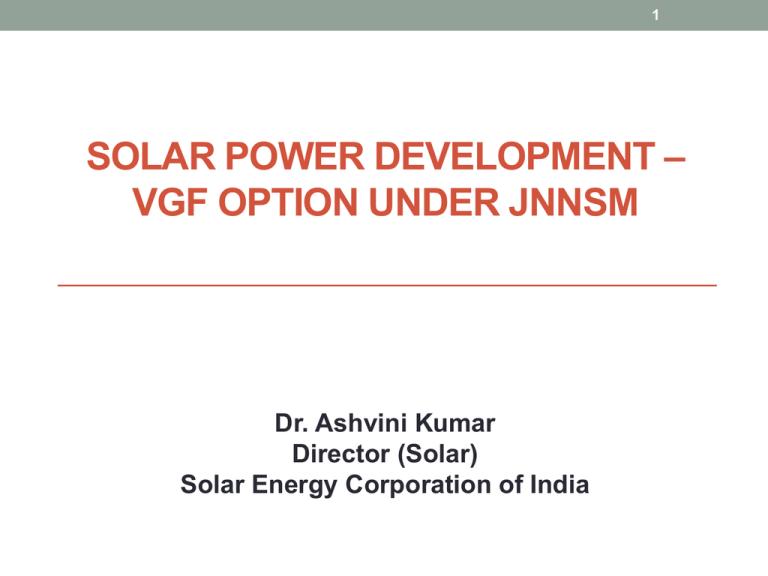event_20-78-1-518c9ea715aae
advertisement

1 SOLAR POWER DEVELOPMENT – VGF OPTION UNDER JNNSM Dr. Ashvini Kumar Director (Solar) Solar Energy Corporation of India 2 SOLAR ENERGY CORPORATION OF INDIA A Government of India Enterprise under the administrative control of MNRE. Incorporated on 20th September 2011. Under Section-25 of the Companies Act, 1956. “Not for profit” company. Authorised capital of Rs 2,000 Cores 3 SECI Activities Broad mandate : Implementing & Monitoring agency of JNNSM from “Concept to Commissioning” Apart from the mission activities SECI is doing the following projects. Solar PV power plants. Solar Mini/Micro Grids Solar Thermal Power Plants Solar Water Heaters Solar Roof-Top Systems Solar Home lighting and Solar Street lights Hybrid projects 1. Solar + Gas 2. Solar + Biomass 3. Solar + Hydro/Pump Storage R&D activities. 4 JNNSM Road Map Application Segment Grid solar power (large plants, roof top & distribution grid plants) Off-grid solar applications Solar Thermal Collectors (SWHs, solar cooking/ cooling, Industrial process heat applications etc.) Solar Lighting System Target for Phase I (2010-13) Cumulative Target for Phase 2 (2013-17) Cumulative Target for Phase 3 (2017-22) 1,100 MW 10,000 MW 20,000 MW 200 MW 1,000 MW 2,000 MW 7 million sq. meters 15 million sq. meters 20 million sq meters 5 million 10 million 20 million 5 Policy and Regulatory Support Regulatory measures- RPO/REC Supporting grid connected projects to bring volumes and reduce prices Financial support for off-grid Support R&D in India Encourage manufacturing HR development 6 Ground Measurement of Solar Radiation Andhra Pradesh 6 Gujarat 11 Haryana 1 Madhya Pradesh 3 Karnataka 5 Rajasthan 12 Chhattisgarh 1 Ladakh 1 Maharashtra 3 Pudducherry 1 Tamil Nadu 6 • C-WET is implementing the project for setting up 51 ground monitoring stations • Centralized data collection, analysis and calibration of measuring sensors State Initiatives S. No State Solar Specific Programme 1. Gujarat Announced – 968.5 MW Commissioned – 857 MW 2. Maharashtra Commissioned – 100 MW (includes 40 MW setup in Rajasthan under RPO). Under installation: 150 MW at Sakri/ Dhule 3. Karnataka Commissioned – 8 MW , Approved plan for 200 MW Bids invited/allotted– 70 MW, Min. tariff – Rs. 7.94/unit Bids to be invited-130 MW 4. Rajasthan Tendered – 200 MW, 75 MW at Rs. 6.45/Unit awarded 5. Odisha Announced -50 MW Awarded – 25 MW, Minimum tariff – Rs. 7/unit State Initiatives (2) S. No State Solar Specific Programme 6. Uttar Pradesh Announced – 500 MW till March 2017 (10 yr PPA) First Phase – 200 MW 7. Andhra Pd. Policy announced in November 2012 for 1000 MW (1 – 5 MW, Rs.6.49/Unit) 8. Tamil Nadu Announced – 3000 MW Tendered-1000 MW Bids received - 498 MW (60 MW bids < Rs 7: 200 MW bids - Rs 7 to 8; 141 MW bids between Rs 8 and Rs 10; 75 MW bids > Rs 10. 9. Madhya Pradesh Awarded– 200 MW Minimum tariff – Rs. 7.90/unit (Alpha-20 MW), Rs 8.05/Unit (Welspun – 125MW) Growth of Solar Capacity (MW) 1800 1684 Solar Capacity (MW) 1600 1400 1200 1000 936 800 600 400 200 3 11 36 0 2008-09 2009-10 2010-11 2011-12 2012-13 State MWp % Gujarat 857.9 50.96 Rajasthan 551.2 32.74 Maharashtra 100.0 5.94 Madhya 37.3 Pradesh 2.22 Andhra Pradesh 23.2 1.38 Uttar Pradesh 17.4 1.03 Tamil Nadu 17.1 1.01 Jharkhand 16.0 0.95 Karnataka 14.0 0.83 Orissa 13.0 0.77 Punjab 9.3 0.55 Haryana 7.8 0.46 A & N Island 5.1 0.30 Uttarakhand 5.1 0.30 Chhattisgarh 4.0 0.24 Delhi 2.6 0.15 West Bengal 2.1 0.12 Lakshadweep 0.8 0.04 10 MNRE Strategy for Phase II Award of capacity to be spread out over Initial two years of plan period as: It facilitates planning for manufacturers as well as developers Learning from prior development would be available for subsequent bids Benefits of cost reduction could be achieved More states could come up the curve to participate in the process Maximize chances of achieving targets within desired timelines Preferably bidding process for allocation of target capacity to end before 2015-16 Lower dependence on Bundling 11 Domestic Content – Key for Phase II Development of 4-5 GW of manufacturing capacity is one of the objectives of JNNSM Current manufacturing (Module) capacity (SPV): ~2000 MW Cheaper international loans available with imported components DCR conditions under schemes entailing direct funding support by Central Government could facilitate development of domestic manufacturing capacity base. 12 Policy Initiatives for Further Growth in Solar Power Capacities • Policy hallmark during Phase 1 was bundling of solar power with cheap thermal power • Phase 2 envisages to reach 10 GW utility scale solar power capacity by March 2017. • 4 GW under central scheme and 6 GW under various State specific schemes. • Other Schemes are • Grid Connected Roof Top Solar PV Power systems • CSP Pilot Projects • Provision of Viability Gap Funding (VGF) • Bundling is subject to availability of unallocated thermal power 13 Draft Features of VGF Scheme Tariff to be paid to the developer : Rs.5.45/kWh, fixed for 25 years 10% less viz., Rs. 4.95/kWh for projects availing benefit of Accelerated Depreciation Payment of VGF Developer’s equity up to 30% of project cost limited to Rs. 2.5 cr./ MW, through competitive bidding. Minimum Rs.1.5 cr./MW Balance can be raised as Loan. 14 Release of VGF amount VGF to be released in three tranches– 25% at the time of delivery of at least 50% of major equipment at site; Weightage: Modules PCUs Switchgear & Transformer Mounting Structures -40% -20% -20% -20% 15 Release of VGF amount 50% on successful commissioning; Balance 25% after 1 year of commissioning meeting requirements of generation If – – – during PPA duration of 25 years: the project fails to function at any time, or its assets are sold, or the project is dismantled, SECI will have right to claim assets equal to VGF paid. Legal documentation to be prepared by SECI. 16 Min. & Max. Capacity Min. Capacity of each project – 10 MW Max. capacity – 50 MW Max. 3 projects at different locations by one developer, subject to a max. of 100 MW. Capacity will be the AC output at the project bus bar located within project premises. 17 Grid connectivity Inter-connection with Transmission network of STU/CTU/any other Utility at level of 33 KV or above. Developer to submit along with Bid a letter from STU / CTU/ Transmission Utility confirming technical feasibility of connectivity of plant to substation. Transmission of power up to interconnection point where metering is done for energy accounting, to be responsibility of Developer at own cost. 18 Grid connectivity (contd.) Option of Pooling Point where more than one SPV projects may connect Common Transmission Line (CTL) to further connect Pooling Point to the Interconnection/Metering point. CTL to be built and operated by the developer/any third party/by STU on behalf of developer. Metering to be done at the Interconnection Point along with subsidiary meters at the Pooling Point to determine the generation by each project. 19 Tentative Schedule No. Event Date 1 Request for Selection (RfS) notice May 2013 2 Receipt of applications against RfS 1st Week June 2013 3 Short-listing of projects based on applications received and evaluation of bids Mid August 2013 4 Issue of Letter of Intent (LOI) 1st Week Sept 2013 6 Signing of PPA 1st Week Oct 2013 7 Financial Closure By April 2014 8 Commissioning of projects By December 2014 Pilot Solar Thermal Power Projects • JNNSM document envisages setting up pilot projects to address issues related to optimization and use of improved/advanced technology options - Advanced technology configurations which could lead to cost reduction through higher efficiency and CUF, and scale effect - Reduction in water consumption and footprint land area in solar thermal projects - Potential for replication in commercial projects soon after success of demonstration projects - Potential for indigenous manufacturing • MNRE constituted a multi-stakeholders Group in January 2011 to discuss and suggest technology configurations Project Configurations and Sites Based on recommendations of the stakeholders group and site visits by experts, identified pilot projects to have the following configurations: Project Configuration Identified sites and Broad Specifications With hybrid cooling Bhadla (Rajasthan) Reduced (<= 30%) consumption Available Land Area: 150 ha of water Capacity: 40 MW est. CUF: 29% est. High operating temperature Charanka (Gujarat) Available Land Area: 140 ha (>=500ºC) Higher efficiency Capacity: 35 MW est. CUF : 30% est. Terkuveerapandiyapuram (Tamil Nadu) Large thermal storage Available Land Area: 160 ha (about 8 hours) Capacity: 25 MW est. CUF : 45% est. Large thermal storage Nennala (Andhra Pradesh) Base load Available Land Area: 160 ha Capacity: 20 MW est. CUF : 65% est. Project Details Solar Energy Corporation of India to implement the project Target tariff of solar power – Rs 5.83/ Unit for 25 Years Project selection through ICB for viability gap funding Framework of Support At least 20% of the project cost to come as equity from the project developer. Debt portion could comprise of at the most 50% of the project cost from CTF / ADB; The maximum amount of VGF would be upto 40% of the project cost. Estimated project cost = Rs. 2,555 Crore NCEF Committee Chaired by Expenditure Secretary approved the project with Rs. 1020 crore of support Roof Top Solar PV Power Projects Grid connected Rooftop Projects to be supported by grant as capital subsidy for self consumption of Solar Electricity and feeding extra power to grid whenever available. Basic aim is to mitigate consumption of diesel. The scheme is implemented in two modes, viz., Capital Grant @ 30% of project cost, and RESCO mode with some grant and a provision of tariff from the consumer. Scheme is implemented by SECI through competitive bidding in select cities. Project size to be 100 kW to 500 kW, however, aggregation of capacity from smaller projects is allowed. Balance cost is to be met by the consumer. Grid connectivity and metering is to be in accordance with CEA guidelines or SERC’s regulations. Status of Implementation • Phase-I already started with the following allocations: Chennai – 2 MW Bangalore – 2 MW Delhi – 1 MW Gurgaon – 0.5 MW • Phase-II: Bids invited for a capacity of 11.1 MW: Jaipur – 3.1 MW Bhubaneswar – 1 MW Hyderabad – 2 MW Gurgaon – 1.5 MW NOIDA/ Gr. NOIDA – 1.5 MW Raipur – 2 MW 25








